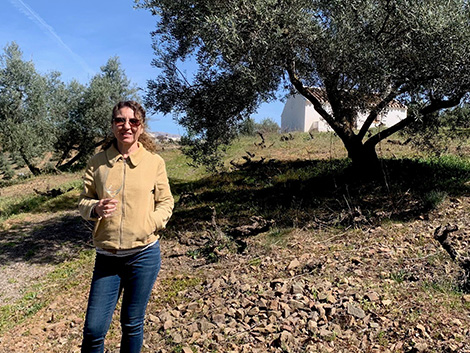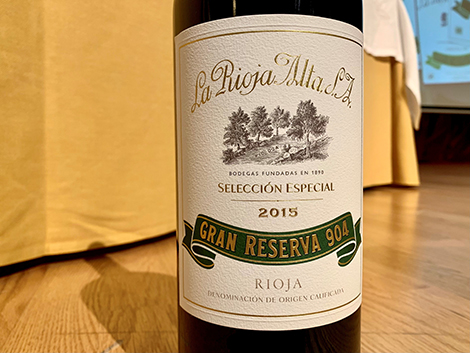Victoria Ordóñez and her mission to breathe life back into Montes de Málaga

It is hard to believe that much of the land of the Montes de Málaga, a dramatic series of bare hills where farmers grow their crops on ravines and dramatic cliffs, lies within the boundaries of the vibrant city overlooking the Mediterranean, one of Spain's most popular destinations for its exciting cultural and culinary life.
What now seem like two separate worlds were once closely united by wine. Much like with Port wine, grapes were fermented in cellars dotted around the hills and then transported to the port of Málaga, where Dutch, English and German merchants refined the wines before shipping them to their final markets. Powdery mildew and later phylloxera, which entered the Iberian Peninsula through Malaga in 1878, put an end to several centuries of winemaking splendour.

"The Riparia rootstocks never worked in Montes de Málaga," explains Victoria Ordóñez. "And the Rupestris, which came later, had to be dug deep into the ground, which is quite a challenge when the bedrock is close to the surface. After phylloxera, the farmers spread the risk by planting almond and olive trees. Today, finding vines in this area is like looking for needles in a haystack, but this is exactly what Victoria Ordóñez has been doing since 2015.
From medicine to wine
Her goal is to revive this forgotten territory, as well as its signature grape variety, Pedro Ximénez. It is a lifelong project that has grown steadily as the Malaga-born winemaker immersed herself in the history of the region. It is highly likely that Victoria Ordóñez's background (she holds a PhD in Medicine and has extensive experience in health management) naturally directed her to research further afield. In fact, her last position before giving up her white coat was director of IMABIS, a public institution dedicated to biomedical and health research.
Although she grew up in a wine-friendly household (her family ran a wine distribution business in Malaga), she could never have imagined that helping her brother would change her life forever. The man is Jorge Ordóñez, a pioneering importer of Spanish wines to the US who was relatively close to Robert Parker when he was the world's most powerful wine critic. Jorge also earned a reputation as a hard-nosed, imposing man who was behind some high-profile business break-ups.
His project was launched in the Axarquía, the wine-growing region that borders the Montes de Málaga to the east. Vines had been cultivated here for a long time, mainly for the production of raisins, but at the beginning of the 21st century a new trend was emerging: naturally sweet, unfortified wines produced close to the vineyards, as opposed to the old tradition of ageing in the cellars of the port. Jorge Ordóñez enlisted the help of a leading specialist: Austrian winemaker Alois Kracher, who at the time was behind some of Europe's most sought-after late harvest and ice wines. "I intended to help only with the admin, but Kracher insisted on bringing me in and teaching me everything from harvesting and grape selection to barrel ageing and how to make a dry Moscatel. As a result, I am now the only person in my family who makes wine with their own hands," says Victoria.

She spent four harvests juggling her two occupations, but in 2008 the wine took over and she left her job at IMABIS. In 2015 she parted company with her brother to develop a "21st century version" of the famous Pedro Ximénez from Montes de Malaga.
Honouring Pedro Ximénez
This may explain why Victoria is so irritated by historical inaccuracies. Especially when it comes to the legend of the Spanish soldier from the Flanders infantry who was said to have brought the variety to Spain. As a researcher, she is far more intrigued by the fact that DNA studies have proven that Pedro Ximénez is a descendant of Heben (or Gibi), an Arab table grape that spawned many other varieties in the Iberian Peninsula, such as Airén, Viura, Xarel.lo or Cayetana Blanca.
Although Pedro Ximénez is now more widely grown in the Norte sub-region of the DO Málaga, it has been firmly established in the province for centuries. The first historical record dates from 1540 and is a notary deed concerning the purchase and sale of vines. In his Topographie de tous les vignobles connus, published at the beginning of the 19th century, André Jullien described it as "the best among all the varieties grown in Spain."
The most detailed records are found in Disertación en recomendación y defensa del famoso vino malagueño Pero Ximen y modo de formarlo, a comprehensive work by Cecilio García de la Leña that was published in 1792 (read more about it here). The book describes all the varieties grown at the time, as well as the meticulous selection and painstaking work that went into making the famous Pedro Ximénez white. He also distinguishes between early, mid- and late-ripening or "de los Montes" plots. Of the latter, he wrote: “Pedro Ximen, the most representative son of these Montes, is one of the mellowest, most fragrant, spirited and special grapes in Spain and even in Europe.”

Victoria Ordóñez believes that the jewel in the crown of these late-ripening plots is the land that reaches into the foothills of Santo Pitar, a summit topped with antennae and rising to 1,020 metres. She sources grapes from the few remaining vineyards in the area (one of which planted with pre-phylloxera vines) farmed by local growers to make Voladeros, a dry, barrel-fermented Pedro Ximénez that recalls the famous mountain wines shipped from the port of Málaga.
The exquisite label features an engraving of the bay and mountains of Malaga from the 1800s, which is actually a recreation of an earlier work attributed to the Flemish artist Joris Hosfnagel and included in the atlas Civitates Orbis Terrarum, published in Antwerp and Cologne in 1572. "Volaero" is the popular name for the cliffs in Málaga. There is an entire universe of local stories that tell of the past and the region's culture.
Montes de Málaga vs Axarquía
Although her business is firmly rooted in the Montes de Málaga, Victoria has not lost touch with the Axarquía. She still buys Moscatel from the area - it represents 30% of the blend of Jábega, a new, substantial entry-level white aged on the lees for 12 months in stainless steel tanks. In her flagship white, La Ola del Melillero, the proportion of Moscatel drops to just 10%.
Apart from varietal specialisations (Moscatel for raisins in Axarquía, Pedro Ximénez for wine in Montes de Málaga), there are some significant differences between these two neighbouring areas. From a geological point of view, the Montes belong to the so-called Maláguide formation, which originated in a marine chasm during the Precambrian period. It is therefore a very ancient formation, which has undergone subsequent transformations and depositions, resulting in a great complexity of materials such as phyllites (slate), limestone, grauwackes (rocks formed by the decomposition of granite), silica and magmatic intrusions. Axarquía, on the other hand, is part of the Alpujarra formation, which was created much later, in the Lower Triassic, and is mainly slate with a high proportion of quartz.
In both cases, heroic viticulture is called for as the vines are planted on extremely steep slopes where mechanisation is impossible. The elevation is remarkable, despite the proximity of the sea (Victoria Ordóñez's vineyards are between 800 and 1,000 metres above sea level). The poor soils, particularly in the Montes area, mean that yields are very low, rarely exceeding 1,000 kg/ha.
A second significant difference has to do with farming estates and architecture. Whereas in Axarquía the paseras, the places where the grapes are left to dry, take centre stage, in the Montes de Málaga the emphasis is on winemaking. As a result, the buildings had a dual purpose: as homes and as wine-making facilities. "The lagares, where the grapes were pressed and fermented, were the summer residences of the 17th-century bourgeoisie; they were built on the top of the hills to make the most of the slope and move the wine by gravity," explains Victoria.

"I wanted to vinify Moscatel in a way that had never been done before. I used the finest barrels because the variety can deliver its best when handled appropriately," says Victoria. The equivalent of Voladeros in Axarquía is Monticara, named after one of the mountains in the region. With a similar design, the label features a bespoke drawing of the Zafarraya Gorge, a natural pass through the mountains into the province of Granada, and two figures strolling in 19th-century clothing, one in the Málaga style, the other in the English style. The eloquent legend "Vines on elephants' backs" is inspired by the rounded peaks of the mountains, which, cut through by deep gorges, resemble the silhouette of these pachyderms.
The Voladeros and Monticara labels not only show a true love of the land and its history, but also a blind faith in its greatness. They really make you believe that there is something very special inside the bottle.
Oak barrels, time and an orange wine
In her active exploration of Montes de Málaga, Victoria Ordóñez has been able to purchase seven hectares of vineyards, a good part of which are clustered in a beautiful, organically certified estate, with a small farmhouse, old vines winding down the hillside, and fruit trees dotted here and there.
From the Pedro Ximénez grapes grown here, she makes a new orange wine called "Pero Ximén de los Montes de Málaga Macerada con su Piel" (Pero Ximén from Montes de Málaga Macerated with its Skin). With only 11.5% abv and aged for a year in oak, it is a subtle and elegant wine.
Victoria makes the wines she likes to drink: "dry, refined and low in alcohol", although she admits that this can be difficult to achieve as ripeness can change dramatically in a matter of hours. With Voladeros, she has never exceeded 13% abv but she is exploring a range between 10.5% and 13.5% abv for Pedro Ximénez and between 12.5% and 14.5% abv for Moscatel. At 14.5% abv, Monticara 2019 is rich and full-bodied, but she will not make it in 2022 because it was an extremely hot year.

She is also a great advocate of oak ageing, which she sees as a natural step in the winemaking process. "The barrel is the best container for wine and brings out the best in it. We women have dedicated our lives to nurturing, and wine is just that. Wine needs care and attention, just like a human being, and it also changes over time," she says.
She has tried to prove this with the release of Ghiara 2017, which is simply the best Voladeros barrel, left to mature for four years. There are only 303 magnum bottles, proudly priced at €100 each. This is a serious, mature expression of Pedro Ximénez with all the extra complexity that comes with time. Once again, the name tells a story. Baldomero Ghiara was Picasso's uncle and mentor, but also, according to Victoria, the last great producer of mountain wines at his El Lince estate. With Ghiara, she has simply replicated the way he made his wines. Now she is pushing the boundaries with a 2016 barrel that she consistently refills with Pedro Ximénez from each new vintage.

Red wines
Since 2016, Victoria leases 4.5 hectares in La Fresneda, a vineyard in the village of Antequera planted to Tempranillo, Cabernet Sauvignon, Petit Verdot and Syrah. This is a cold, elevated area at 800m above sea level, just beyond the historic boundaries of Montes de Málaga, with interesting limestone soils.
The few vineyards in the area that are not grown with local varieties are the result of planting rights granted in the 1990s, when international red varieties were in vogue. In this vein, Victoria also sources three hectares of red grapes from Cerro del Moro, planted 30 years ago at 900 metres elevation, this time within the boundaries of Montes de Málaga.
She produces a total of five red wines. The entry-level Jábega includes a directly pressed rosé and a red cuvée. The other three come from La Fresneda. These include two Camorolos, a red blend and a Syrah with the façade of the 19th-century farmhouse that dominates the estate on the label, and the top-of-the-range Martí-Aguilar, with around 60% Petit Verdot, a variety that Victoria believes is well suited to the area.

Although it is difficult to draw attention to international varieties at a time when Spain is busy recovering its traditional grape varieties, it is worth pointing out that the expression of these reds from Malaga is completely different from anything else produced in other Spanish regions. The wines stand out for their acidity (the pH is very low in these acid soils), their restrained structure and the character that the soil imparts on the finish. "If you taste them, you buy them," says Victoria confidently. So far, Andalusia has been their best market, but they are now starting to be exported to some international markets.
Similarly, in the case of the whites, there is a strong emphasis on creating wines that feel dry on the palate and on using oak judiciously. These wines, on the other hand, are somewhat detached from fashions, which is probably explained by the mental and geographical isolation of Montes de Málaga and the fact that this is the only project that is strongly rooted in the area.
After spending the day searching rather than visiting the vineyards and tasting the wines, a common pattern emerged in the glass with the presence of herbal and scrubland aromas. Could this be related to the strong influence of the surrounding countryside, given the isolated and residual nature of the vineyard? Would these aromas be found in the dry Pedro Ximen described by García de la Leña in the days when these mountains were covered with vineyards as far as the eye could see?

Amaya Cervera
A wine journalist with almost 30 years' experience, she is the founder of the award-winning Spanish Wine Lover website. In 2023, she won the National Gastronomy Award for Gastronomic Communication
NEWSLETTER
Join our community of Spanish wine lovers






